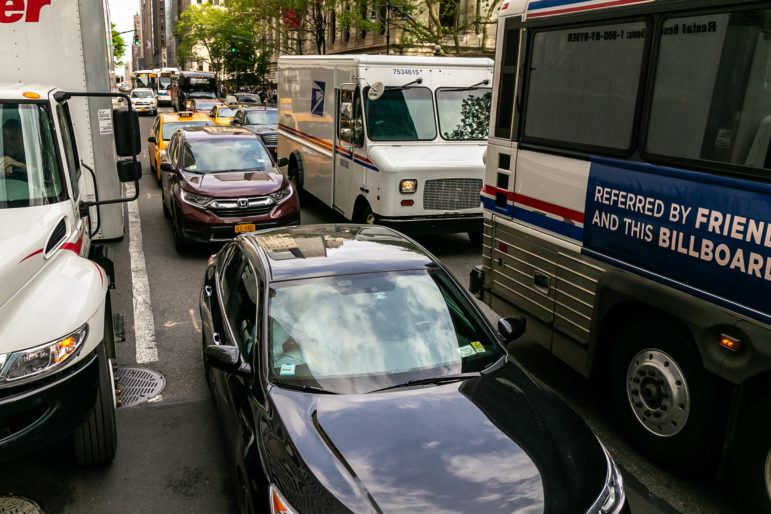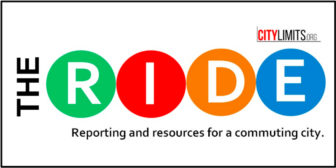
Adi Talwar
Friday evening traffic heading West on 42nd Street between 5th and 6th Avenues in Manhattan.
Come 2021, drivers will have to pay a toll to enter Manhattan south of 60th Street—the result of New York’s recently-passed congestion pricing plan , which lawmakers say will allow the state to leverage $15 billion in revenue to help rebuild the struggling subway system.
Many details of congestion pricing have yet to be determined. The MTA’s Triborough Bridge and Tunnel Authority is charged with forming a six-member panel to hash out the specifics, including exactly how much drivers will pay and whether to offer exemptions to certain groups or vehicles, according to state’s plan. And calls for exemptions have been plentiful: police officers want one, truck drivers want one and even the state of New Jersey wants one.
Most transit advocates oppose offering exemptions, on the grounds that doing so will chip away at toll revenue the MTA badly needs. But one subset of drivers pushing for a carve-out argues their exemption would actually help the city achieve several its congestion pricing goals: the owners of electric cars and other fuel-efficient vehicles—including motorcycles and scooters—who say doing so would incentivize those who do drive to swap out their gas guzzlers for less-polluting models.
“We’re part of the solution. We reduce congestion,” says Cheryl Stewart, a longtime motorcycle rider and founder of the group Riders Against Congestion, which is pushing to get two-wheeled vehicles exempt. “It doesn’t make sense to lump us in [with cars].”
She points to Department of Energy data listing motorcycles as more fuel-efficient than cars, as well as a2007 study by transit expert Sam Schwartz which found congestion and pollution would be reduced if more motor scooters filled the city’s streets instead of cars (Schwartz, however, has more recently stated his opposition to any congestion pricing exemptions).
Stewart argues that residents who live in neighborhoods underserved by public transit are forced to rely on driving more than those in other areas. As a freelance sculpture who lives in Red Hook, where there’s limited subway access, she travels to work sites on her motorcycle, which also allows her to transport her tools.
“Advocates who are really adamant that no exemptions would be given at any time, I bet they probably don’t live in a transportation desert as I do,” she says. “Incentivizing motorcycles is a reduction strategy.”
Other cities have made exceptions
For motorcycle usage to be truly effective as means of reducing congestion, New York would need to legalize lane-splitting, which would allow motorcyclists to drive between lanes to move faster through traffic, something Stewart supports and others users havepushed for on the grounds it would free up more space on the road. The practice is legal in California, and seven other states were considering bills to legalize lane-splitting as recently as last year, according to a report from Pew Charitable Trusts. The NYPD has previously stated its opposition to the practice, citing safety concerns.
Other cities that have already implemented road tolling plans have made exceptions for certain vehicles: In Stockholm, for instance, motorcycles and mopeds don’t have to pay the congestion tax. When London introduced congestion pricing more than a decade ago, motorcycles were also exempt from the fee, and drivers of certain electric and hybrid vehicles could get a discount. Since last month, however, all older vehicles that don’t meet certain efficiency standards aresubject to a charge to enter London’s congestion zone.
There are currently almost 8,000 electric cars and nearly 45,000 motorcycles registered across the five boroughs, state data shows.
At least one New York lawmaker, Assembly Member Felix Ortiz, wants lower-emission vehicles exempt from the city’s future congestion fees, citing London as an example. He introduced a bill in March that would exclude clean-fuel and electric cars from the tolls, and another bill to exempt motorcycles.
“This legislation seeks to give an incentive for New Yorkers to help change the ramifications of carbon emissions which is one of the largest contributors to climate change,” both of Ortiz’s bills read. “There should be incentives not penalties for owners who want to contribute to saving our planets [sic] future.”
Others made a similar argument in March at a hearing on congestion pricing hosted by Manhattan Borough President Gale Brewer.
“Scooters and motorcycles are much smaller and weigh a lot less than cars, so they use only a fraction of our limited parking spaces and put a lower burden on roads’ surfaces,” said Christine Negra, one of several motorcycle users who testified at the event.
Both the city and state have campaigned—and allocated funding—to get more New Yorkers to switch to environmentally-friendly cars. Last year, Gov. Andrew Cuomo launcheda $250 million initiative to increase the number of electric vehicle charging stations across the state, while Mayor Bill de Blasio’s aiming to have EVs account for 20 percent of registered cars in the city by 2025.
Concerns about carve-outs
Last month, a new coalition of environmental and transit advocacy groups launched ElectrifyNY , an effort to get the city and state to switch over to an all-electric public bus fleet and make other carbon emission-reducing changes. In a statement, the collective told City Limits it does not yet have a formal position on congestion pricing exemptions, but that it will be monitoring discussions as the details get hammered out in the coming months.
“Our initial take is that the more exemptions we grant, the less revenue for the subways, which critically need it. While EVs pollute less, they nevertheless contribute to congestion of non-EV traffic,” Eddie Bautista, executive director of the New York City Environmental Justice Alliance and an ElectrifyNY member, said in an email.
He points out that EV owners tend to be of higher-income, and so exempting them would make the congestion pricing deal “more regressive”—a fear often expressed by opponents of road pricing who worry the tolls would disproportionately burden low-income people (though supporters point to data that shows car-owners are generally wealthier).
To the degree exemptions are considered, in the past, we’ve been open to exempting people with disabilities or folks who have to travel to the zone for doctor appointments (we were also advocates of once-a-day tolling, and generally during the work day),” Bautista added. “Beyond that, it becomes a slippery slope.”
If fuel efficiency exemptions were instituted, the TBTA panel tasked with crafting the state’s congestion pricing plan would have to decide exactly what kind of vehicles would qualify for the carve-outs. The state’s current standards for its Low Emission Vehicle Program includes battery electric vehicles, fuel cell vehicles and electric hybrids, according to the Dept. of Environmental Conservation.
Stewart of Riders Against Congestion argues that failing to create any exemptions for motorcycles and lower-emission vehicles is placing the need for toll revenue over the goal of reducing street traffic.
“I feel like, frankly, some of or many of the lawmakers who’ve signed onto this, they’re not thinking about congestion,” she says. “It’s all about the money.”
But others argue that it makes sense to prioritize funding, considering the dire state of the city’s public transit system, where the subway has operated in a state of emergency for the last two years.
“New York’s congestion pricing is, in large part, about revenue,” says Nick Sifuentes of Tri-State Transportation Campaign, which is also a member of ElectrifyNY. While he feels reducing congestion is still “incredibly important,” the ultimate goal is get more people on public transit and out of vehicles altogether.
“We’re trying to encourage people to take mass transit, not flood the streets with EVs or motorcycles,” he says.
Sifuentes says there are other tactics outside of congestion pricing exemptions that the city and state can undertake to incentivize the switch to electric and fuel-efficient vehicles, including expanding the number of EV charging stations. He also points to policies like one in Los Angeles, which rewards drivers of certain environmentally-friendly cars by letting them use carpool lanes even if they’re driving alone.
But someday, he adds, it might make sense for New York to exempt electric and other less-polluting vehicles from congestion pricing—but for now, raising revenue to save the public transit system should come first.
“Let’s say 10 years from now, we’ve done Fast Forward and the subways are brilliant and they’re up to modern standards again and the bus network is humming along,” he says. “Maybe then we’d tweak our program; maybe that’s when we say we’ll allow [exemptions].”
The six-person Traffic Mobility Review Board charged with hammering out the details for congestion pricing, including any exemptions, is required to submit its recommendations sometime after Nov. 15 of 2020, the MTA says. The board’s members will be appointed by the TBTA, with the exception of one member, who will be appointed by Mayor Bill de Blasio. No actual appointments have been announced yet.










One thought on “Should Motorcycles and Greener Cars Get a Pass on Congestion Pricing?”
Electric cars should have a temporary discount to increase popularity, then they should be charged the full price because they will contribute to congestion.
Motorcycles/scooters should get a discount, perhaps 50% off.
All ICE powered passenger vehicles and motorcycles/scooters should be banned in NYC by 2040 at the latest.